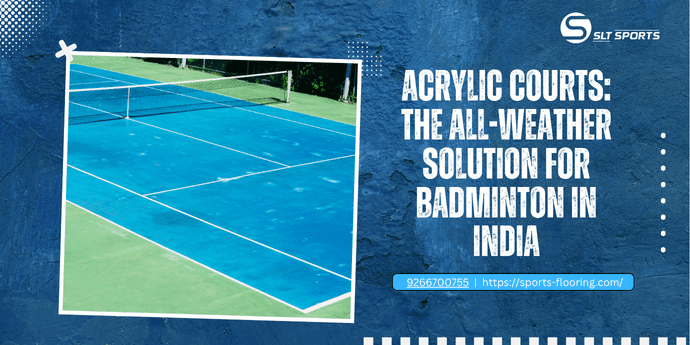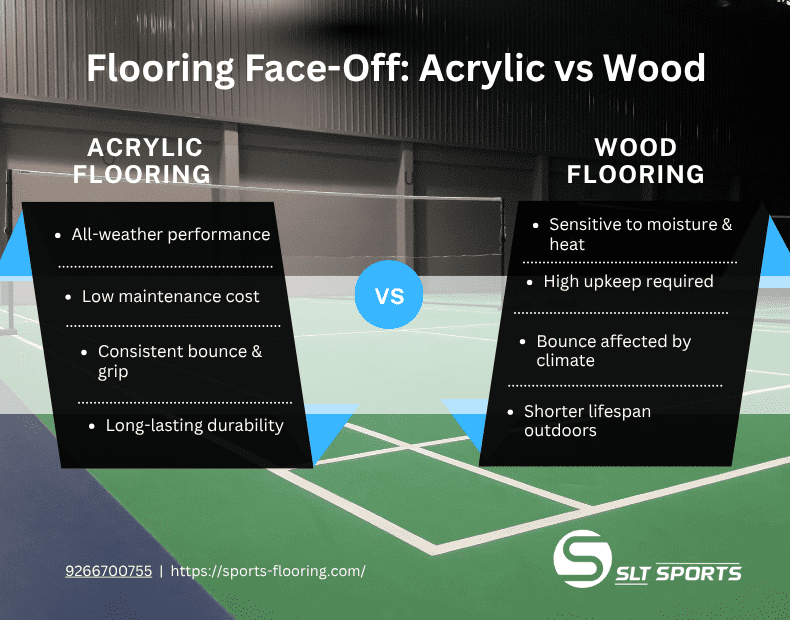
Setting up a badminton facility in India needs careful thought about the badminton court flooring. Picking the right flooring plays a big role in how well players perform and stay safe. It also affects how much upkeep the floor needs and the overall cost in the long run. Wooden floors have been the go-to choice for many years, but acrylic badminton court is now proving to be a better option with India’s tough and varied climate.
There’s still plenty of discussion about whether wood or synthetic courts work best. Facility managers, club owners, and players all have their opinions. But looking at how acrylic flooring benefits India makes it clear why more facilities are making the change. This detailed comparison will break down why acrylic courts in India are becoming more popular than wooden ones.
Learning About Badminton Court Flooring Choices
Kinds Of Badminton Court Surfaces
People choosing badminton court materials pick from two choices:
Wooden Badminton Court Floors: Courts made of wood use hardwood planks placed on a supportive subfloor. These types of courts have been used indoors for a long time. They give a timeless look, and players recognize the familiar surface feel.
Synthetic/Acrylic Badminton Courts: Modern synthetic options use several layers, like a primer, resurfacer, and a textured top layer. Unlike wooden courts, these synthetic ones provide steady playability and greater toughness. This makes them useful in India’s weather conditions.
BWF Guidelines and Needs
To build professional badminton courts, facilities need to follow the BWF-recommended flooring standards in India. The Badminton World Federation gives clear guidelines about court surfaces, which include:
- Requirements for a specific thickness to absorb shocks
- Standards on surface texture to ensure a good grip
- Specifications regarding how impacts are absorbed
- Rules about resistance to slipping
Both wooden and acrylic courts are capable of meeting these standards if installed the right way. However, keeping them up to standard over time can vary a lot between the two.
Important Comparison: Synthetic Badminton Courts vs Wooden Courts
Synthetic and wooden badminton courts have noticeable differences when you compare them.
Performance in Play
Surface Consistency: Acrylic courts offer an even playing field where the ball bounces and players move. Wooden courts, on the other hand, can lose consistency in humid weather as the surface may warp or expand, which is a frequent issue in Indian climates.
Grip and Traction: The textured layer on acrylic courts gives players strong traction and lowers the chances of slipping during fast-paced games. Wooden courts can become unsafe when the polish wears out, leading to slippery areas that make play hazardous.
Shock Absorption: Both types of courts help with shock absorption, but acrylic surfaces retain these benefits over time without much change. Wooden courts, however, might develop firm spots as they age, raising the chance of injuries.
Badminton Court Durability Factors to Adapt to Indian Weather
Research across India shows that acrylic badminton court flooring holds up well under different weather conditions. These courts need less fixing or replacing because of their tough materials.
India has regions where temperatures swing a lot. Unlike wooden courts, which warp and buckle due to expanding and shrinking acrylic courts stay steady no matter the weather changes.
Acrylic courts also shine when it comes to humid weather, making them a better fit for India’s wet monsoons. Wooden courts need extra care in such sticky conditions, but acrylic ones keep their shape without any special upkeep.
UV Resistance: To build an outdoor badminton court, you need surfaces that can handle the sun. Acrylic courts with UV-resistant coatings keep their quality and look even after sun exposure. Wooden courts, on the other hand, don’t work well outdoors.
Maintenance Needs: Something You Cannot Ignore
Many facility managers choose badminton flooring that needs less upkeep to cut costs. The difference in maintenance among various flooring options is significant.
Upkeep for Acrylic Courts
Acrylic flooring works well if you want a badminton court that requires little maintenance in busy sports centers. Basic upkeep involves:
- Cleaning with water and gentle soap
- Doing a deep clean every few months
- Re-applying the coating every 3 to 5 years based on wear and tear
This easy maintenance plan helps avoid long closures while saving money in the long term.
Taking Care of Wooden Badminton Courts
Humidity changes can make a badminton wooden court’s surface uneven. To keep the court in good condition, you need to:
- Use a dust mop every day.
- Clean weekly with wood-specific cleaners.
- Do screening and recoating every three months.
- Sand and refinish the entire surface once every 2-3 years.
- Keep the climate at a steady level to avoid warping issues.
Indian facilities face tough challenges and high costs because of the strict upkeep needs for wooden courts.
Acrylic Flooring as a Better Fit: Handling India’s Climate
India’s varying weather makes badminton court flooring tricky. From dry interiors to the damp air of coastal regions, climate shifts across the country create unique problems.
Seasonal Issues During Monsoons
India’s monsoon brings extreme humidity, which takes a serious toll on wooden courts. Moisture in the air causes wooden planks to expand or even deform, leading to issues like crowning or cupping on the surface. These changes make gameplay uneven and may even harm the structure of the court. Even advanced climate control systems struggle to fully prevent these effects.
On the flip side, acrylic badminton courts handle these humidity changes without any trouble. They offer consistent gameplay no matter the season.
Dealing with Heat and Sun
Heat resistance is a key factor to consider when choosing outdoor badminton flooring. In India’s varied climates, acrylic surfaces stand out as the best pick for outdoor courts. They endure harsh sunlight without losing color, breaking down, losing strength, or altering how the court performs.
This makes acrylic the best choice for use on outdoor courts. It also works well for indoor courts where temperatures might change often.
Comparing the Costs: Wood Courts and Acrylic Courts
A detailed look at wood and acrylic badminton court costs shows noticeable gaps, both in upfront prices and over time.
Costs to Install a Badminton Court
The cost to set up each type of court varies:
- Acrylic floors cost less per square foot.
- Wooden floors tend to cost 20 to 30 percent more to set up.
Though wooden court installation might appear close in price or cheaper at first, the overall expense over time paints a different picture.
Expenses Over Time
To compare the costs of wood and acrylic courts, you have to include maintenance costs in the total calculation.
Wooden Court Costs:
- Refinishing is needed every 2-3 years
- Use of specific cleaning products
- Maintaining climate control systems
- Fixing or replacing damaged parts
- Higher maintenance labor expenses
Acrylic Court Costs:
- Low cleaning expenses
- Recoating is required every 3-5 years
- No need to manage climate systems
- Repairs are necessary
When comparing ownership costs over 10 years, wooden courts cost 40-60% more than acrylic ones. Acrylic courts are cheaper in the long run.
Main Advantages of Acrylic Badminton Courts in India
Acrylic courts offer steady performance during play and less upkeep. They provide several clear benefits.
Performance Advantages of Badminton Flooring
- Reliable Playing Conditions
- The ball bounces no matter where it lands on the court.
- Players can move with good traction.
- Weather doesn’t change how the court performs.
- Improved Safety Elements
- It has great shock absorption to ease strain on joints.
- The surface helps prevent slipping and falling.
- Its evenness lowers the chances of tripping.
- Play Like a Pro
- It matches BWF standards used in tournaments.
- Many top players prefer using it.
- Training and competing feel consistent every time.
Practical Advantages of Badminton Flooring
- Longer Lifespan
- Lasts 10 to 15 years with routine care
- Stays strong against weather-related wear and tear
- Handles frequent use without easily wearing out
- Multi-Use Design
- Works well in both indoor and outdoor spaces
- Adjusts to different subfloor setups with ease
- Comes in a variety of colors to match facility themes
- Climate Compatibility
- Performs in India’s varying weather conditions
- Resists damage from seasonal shifts without losing quality
- Does not need any special climate control systems
Players and court managers value acrylic badminton courts for their safety and toughness. These courts have become a go-to option for both new builds and upgrades.
Standards and Requirements for Professional Badminton Tournaments
Knowing the BWF-approved badminton flooring standards in India matters a lot when setting up courts for competition. Picking the right flooring becomes even more important when the space is meant for training professional athletes or hosting big tournaments.

BWF Guidelines for Badminton Court
Professional venues need to stick to the BWF’s approved badminton flooring options in India for high-level matches. The BWF lays down clear standards for courts used in official tournaments. These include:
- Shock absorption that helps protect players during games
- Surface reflection levels for clear visibility
- Suitable friction to ensure proper traction
- Consistent bounce for the shuttle
Wooden and acrylic courts can meet these standards when they are new, but acrylic courts tend to stay in line with these requirements longer and require less upkeep.
What Professional Players Prefer
Many players like the steady performance that acrylic courts provide in places where the weather changes a lot. These courts offer a stable bounce and good grip, which lets players concentrate more on their game and worry less about uneven surfaces.
Things To Keep In Mind When Installing a Badminton Court
Picking a trusted company to install badminton courts ensures you get good materials and a proper setup. Setting up wooden and acrylic courts involves different methods.
How Wooden Courts Are Installed
Putting in a wooden badminton court involves several steps:
- Preparing the subfloor
- Adding a sleeper system underneath
- Placing and securing the hardwood planks
- Sanding the surface and applying a finish
- Marking the lines
- Letting the court cure for 7 to 14 days
Acrylic Court Setup
Setting up an acrylic badminton court involves:
- Preparing the subfloor
- Adding a primer layer
- Applying an acrylic resurfacer
- Adding a textured topcoat
- Marking the court lines
- Allowing 3-5 days to cure
The easier process of installing acrylic courts brings down both labor costs and the time facilities need to stay closed, making it a better option compared to wood.
Conclusion
Choosing between synthetic acrylic vs wooden badminton court flooring needs careful thought about upkeep and how well it suits local climates. These factors give acrylic options the edge. To build better badminton facilities across India, acrylic courts show strong benefits.
Traditional wooden courts might look nice, but acrylic surfaces have practical advantages that suit modern badminton facilities better in India. Whether you are setting up a new court or upgrading an old one, acrylic flooring offers the right mix of durability, value, and performance.
To get expert advice on choosing the best flooring solution for your badminton facility, reach out to SLT Sports now. Their team can guide you in selecting and setting up the perfect acrylic badminton court for the needs of your space and location in India.
Frequently Asked Questions
In Indian conditions, acrylic badminton court flooring is the better choice due to its durability, weather resistance, and low maintenance requirements. While wooden badminton court flooring offers a traditional feel and bounce, it is more prone to damage from humidity, termites, and temperature changes.
Wood vs acrylic badminton court cost varies based on materials, location, and construction quality. Generally, acrylic courts are more affordable to install and maintain, while wooden courts require a higher initial investment and frequent refinishing.
Low-maintenance badminton flooring like acrylic needs only periodic cleaning and occasional recoating. In contrast, wooden flooring demands regular polishing, moisture control, and potential replacement of damaged planks.
Yes. BWF recommended badminton flooring in India includes high-quality acrylic surfaces that meet international performance standards, ensuring consistent bounce, grip, and safety for competitive play.

